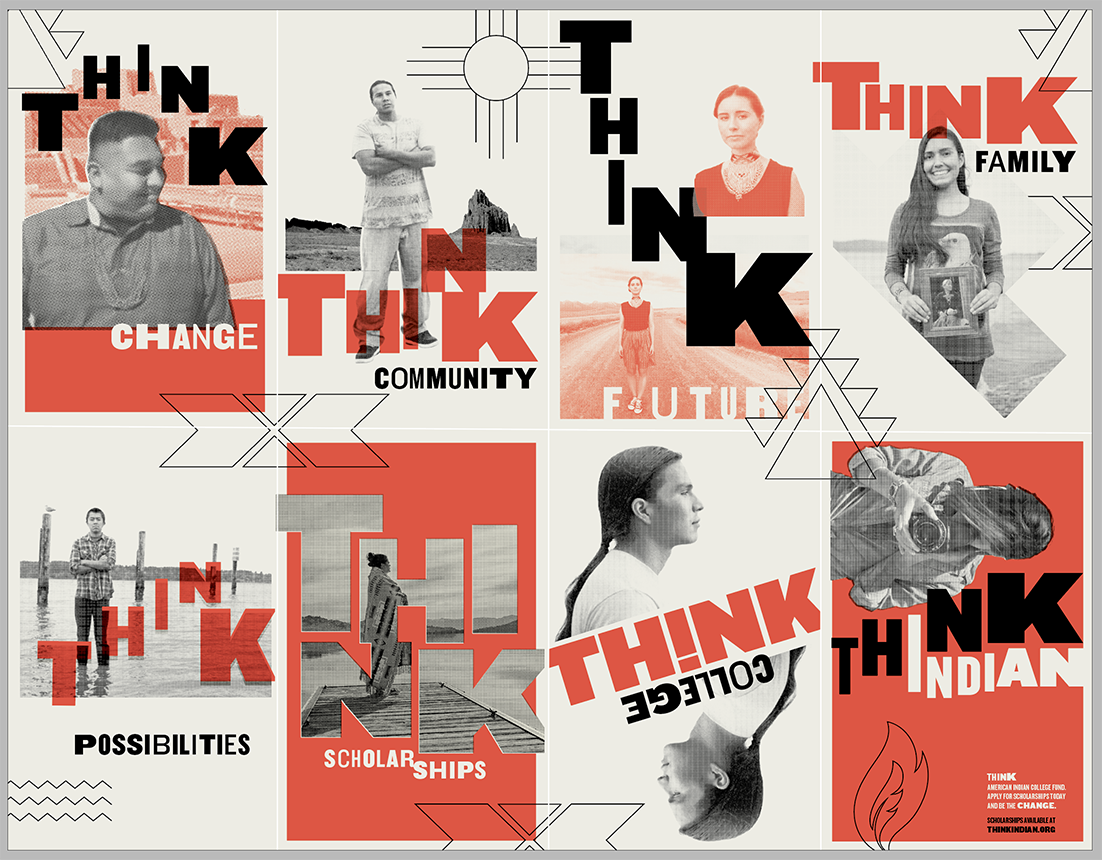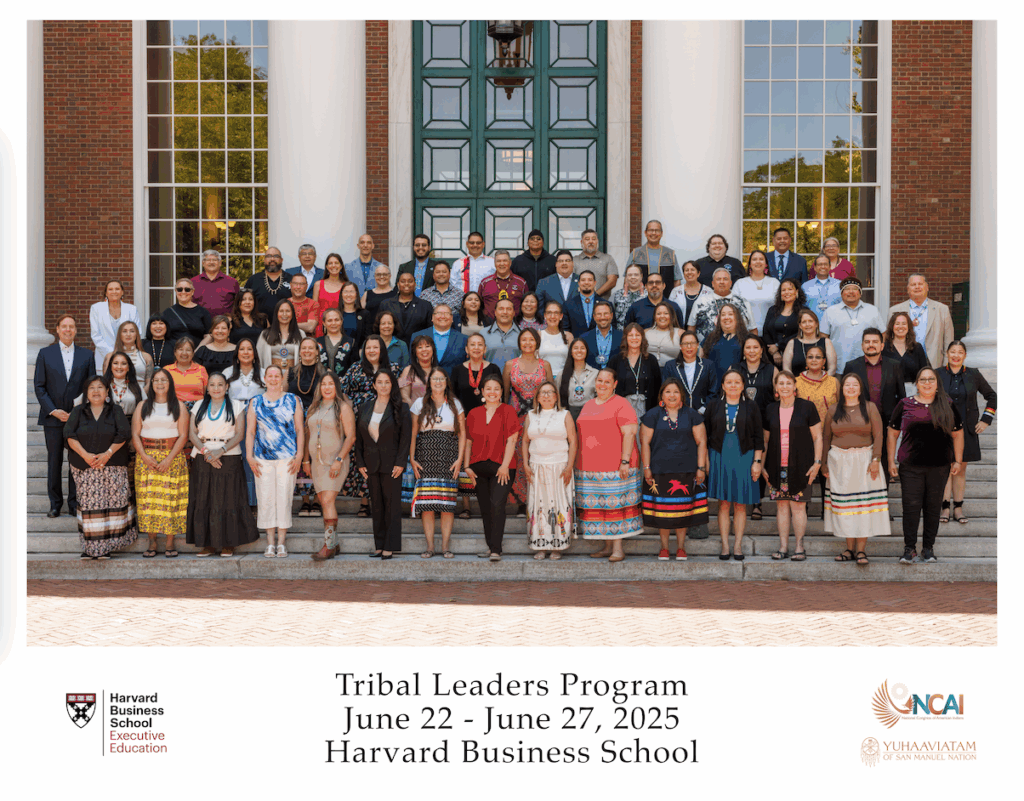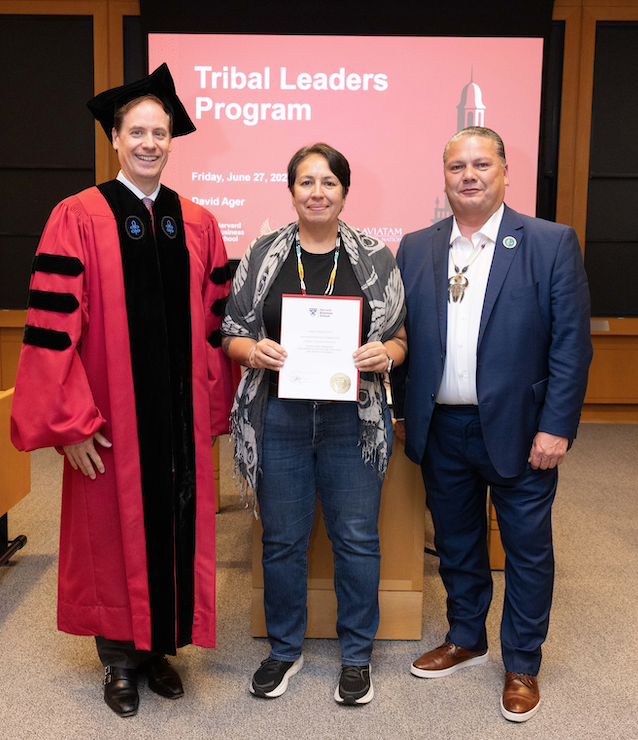Think Indian Community Awareness Grants
 Think Indian Community Awareness Grants of $2,500 are available to student groups and accredited higher education institutions. These grants encourage institutions who serve Native students to promote the positive message of “Think Indian,” the vibrancy of Native students, and the highlight the support provided by Native scholarship programs to their campus and community.
Think Indian Community Awareness Grants of $2,500 are available to student groups and accredited higher education institutions. These grants encourage institutions who serve Native students to promote the positive message of “Think Indian,” the vibrancy of Native students, and the highlight the support provided by Native scholarship programs to their campus and community.
“Think Indian” was originally created as a public awareness campaign to promote the American Indian College Fund, and the many ways that its scholars contribute to, and change our world. Its message connected so deeply with Native students and institutions that it was revived in 2018, specifically to promote the College Fund’s scholarship, and other student programs.
The American Indian College Fund has created a grant program to highlight its “Think Indian” campaign, and scholarships program for Native students. The grants are intended to encourage institutions who serve Native students to promote the positive message of “Think Indian,” the vibrancy of Native students, and the highlight the support provided by Native scholarship programs to their campus and community. Projects must engage or include Native students.
Student groups and institutions can use grant funds for any activity or project that will promote the “Think Indian” campaign and scholarships in their community. Programs can include, but are not limited to:
- Informational, social or artistic events
- Art displays, installations or murals
- Music performances or video screenings
- Local awareness, publicity or marketing campaigns
- Online/social media campaigns
- Participation in existing campus or community events
- Themed volunteer or service events (including Native vote or census projects)
CLICK HERE to view summaries of the 2019 awarded projects.
Related Pages
Students Social Media
News & Events
Emily White Hat, J.D., Vice President of Programs at American Indian College Fund, Chosen to Attend the Leading Tribal Nations Program at Harvard Business School
Emily White Hat, J.D., Vice President of Programs at American Indian College Fund, Chosen to Attend the Leading Tribal Nations Program at Harvard Business School

Denver, Colo., August 7, 2025—Emily White Hat, J.D. (Sicangu Lakota), Vice President of Programs at the American Indian College Fund, was one of 76 participants in the Leading Tribal Nations Program at Harvard Business School in June. The six-day program, held in collaboration with the National Congress of American Indians (NCAI), is designed to equip tribal leaders with the knowledge and skills needed to advance their capacity for strategic governance through collaborative learning and problem-solving through the case-study model facilitated on the Harvard Business School campus.
Participants focused on strategic mindset and leading senior teams of employees, leadership skills in context and crisis, the principles of environmental and resource management, negotiating and thinking in systems for social change, corporate governance and inclusive governance systems, strategic negotiating skills, and more. At the conclusion of the program, all participants received a certificate of completion from Harvard Business School and NCAI.
The Empowering Leaders program was made possible through the support of Yahaaviaatam of San Manuel Nation, Google, and the Robert Wood Johnson Foundation.

Emily White Hat, J.D. (Sicangu Lakota), Vice President of Programs at the American Indian College Fund
Ms. White Hat said, “This leadership program was my first and only formal leadership training. It shifted my mindset to a space of being more open, curious, using systems and forward thinking, and with a focus on becoming a better listener. The program also expanded my network across Indian Country both in the United States and Canada. I’ve been fortunate to work with a Haudenosaunee elder as my executive coach for a little over a year who I can engage with in Indigenous thought and leadership lessons through our cultural and traditional protocols and stories. Being open and vulnerable to learning what mistakes you’ve made as a leader in the past and open to change and growth is powerful and humbling. You acknowledge you don’t know anything. I hope I can be a more thoughtful, intentional, insightful leade. I’m still defining and thinking about my leadership style beyond the conventional terms used leadership styles and how to describe it in Lakota.”
Problem-solving presents an opportunity to think about all parties and map forward and backwards, while thinking about parties and stakeholders involved and considering their concerns, she said. “Change involves loss, and fifty percent of the time leadership is dealing with the losses. To be successful you have a role to help others with the losses. Losses may not always be giving something away.”
And although most leaders are passionate, White Hat said, “Being passionate about your work and service is important, but you have to be intentional in sustaining and nurturing your passion. There is power in recognizing that the work you are engaged in may be a solution that can help other tribal nations, for example. Be open and willing to work on a broader scale, because where you may sit is a space in solution-based work.”
Ms. White Hat is the daughter of the late Albert White Hat, Sr., a revered and respected leader of the Sicangu Lakota Nation and wider Native community. Having grown up with her father and other legendary Indigenous leaders as role models, she said her approach to leadership incorporates Lakota concepts and phrases such as the Lakota phrase Nake Nula Waun, which means she is prepared, anytime, anyplace, for anything. “It took me years to understand that I may not achieve full preparedness for the work ahead daily, but that each day, I am building on this concept.”
The concepts of Lakol wicohan and Lakota iyapi – approaching each day in the Lakota mindset to guide the day and work—involve not only using the Lakota language but also speaking words she knows aloud. “When I approach a new concept, idea, or challenge, I think about what word or words in Lakota represent what I’m doing. If I can identify the word in Lakota, I translate it to English, and it has a deeper meaning and natural direction. If I don’t know the Lakota word, then I identify words in English, and translate them to Lakota and then back to English to reframe the focus in a Lakota mindset.”
Finally, the principle of Unlakotapi wicozani na wowacintanka—strong, healthy, happy, Sicangu Lakota people—guides White Hat’s work. “I want our Oyate (people) to have autonomy, choice, and self-advocacy so they can thrive. Indigenous knowledge is a vital part of our ‘education.’”
“I believe as Lakota and Native people we have the solutions in front of us, in our language, songs, protocols, rituals, ceremonies, medicines, and food. When I reflect on Sicangu leaders like my father Naca Albert White Hat, Sr., great grandfather Itancan (Chief) Hollow Horn Bear, President Cheryl Crazy Bull of the American Indian College Fund, Sarah Kastelic (Alutiiq), Terry Cross, (Seneca), the late Marlene Whiterabbit Helgemo (Ho-chunk), and the late Dr. Alonzo Spang (Northern Cheyenne) and others that have provided space and influenced my leadership, I recognize they put in the time and did the work. They were of service to others. They didn’t wait to be told to do something. They saw the need or a place to help and stepped up to help.
White Hat said the world class faculty members, readings, case study methodology, and role play, along with intense conversations confirmed her values of using the privilege of what she learned to help others.
“I am appreciative of Cheryl Crazy Bull for recommending I apply for the program and supporting me by providing the time to prepare and be present, the College Fund and the Yahaaviaatam of San Manuel Nation for supporting my tuition to attend, the National Congress of American Indians for facilitating the relationship with the Harvard Business School, and the faculty and staff of the Harvard Business School Executive Education Program, specifically David Ager, Taylor Monterio, and Julia Jacobsen.
About the American Indian College Fund — The American Indian College Fund has been the nation’s largest charity supporting Native higher education for 34 years. The College Fund believes “Education is the answer” and provided $17.4 million in scholarships and other direct student support to American Indian students in 2023-24. Since its founding in 1989 the College Fund has provided more than $319 million in scholarships, programs, community, and tribal college support. The College Fund also supports a variety of academic and support programs at the nation’s 34 accredited tribal colleges and universities, which are located on or near Indian reservations, ensuring students have the tools to graduate and succeed in their careers. The College Fund consistently receives top ratings from independent charity evaluators and is one of the nation’s top 100 charities named to the Better Business Bureau’s Wise Giving Alliance and is a Charity Navigator four-star charity. For more information about the American Indian College Fund, please visit www.collegefund.org.
Journalists—The American Indian College Fund does not use the acronym AICF. On second reference, please use the College Fund.
American Indian College Fund Publishes Eighth Volume of The Tribal College and University Research Journal:
American Indian College Fund Publishes Eighth Volume of The Tribal College and University Research Journal:
Features TCU Faculty Research Benefitting Both Indigenous and Research Communities
July 24, 2025, Denver, Colo.— The American Indian College Fund, with generous funding from the Henry Luce Foundation, published volume 8 of the Tribal College and University Research Journal. This one-of-a-kind publication was first launched in 2016 and supports tribal college and university (TCU) faculty in disseminating their academic work to Indigenous communities and the wider research community. The journal publishes articles in a variety of fields such as environmental science, Indigenous health and wellness, student success, and tribal college program development.
Volume 8 contains three articles on the topics of Indigenous approaches to research and sustainability, community-based math resources, and TCUs as sites of healing and resilience. Volume 8 of the research journal can be found on the College Fund’s website at https://collegefund.org/tcurj-v8. Printed copies of the research journal are available at no charge by contacting Heidi Normandin at hnormandin@collegefund.org.
About the American Indian College Fund— The American Indian College Fund has been the nation’s largest charity supporting Native higher education for 35 years. The College Fund believes “Education is the answer” and provided $20.5 million in scholarships and other direct student support for access to a higher education steeped in Native culture and values to American Indian students in 2023-24. Since its founding in 1989 the College Fund has provided more than $349 million in scholarships, programs, community, and tribal college support. The College Fund also supports a variety of programs at the nation’s 34 accredited tribal colleges and universities, which are located on or near Indian reservations, ensuring students have the tools to graduate and succeed in their careers. The College Fund consistently receives top ratings from independent charity evaluators. It earned a four-star rating from Charity Navigator, a Gold Seal of Transparency from Guidestar, and the “Best in America Seal of Excellence” from the Independent Charities of America. The College Fund was also named as one of the nation’s top 100 charities to the Better Business Bureau’s Wise Giving Alliance. For more information about the American Indian College Fund, please visit www.collegefund.org.
About the Henry Luce Foundation – The Henry Luce Foundation seeks to deepen knowledge and understanding in pursuit of a more democratic and just world. Established in 1936 by Henry R. Luce, the co-founder and editor-in-chief of Time, Inc., the Luce Foundation advances its mission by nurturing knowledge communities and institutions, fostering dialogue across divides, enriching public discourse, amplifying diverse voices, and investing in leadership development.
Journalists—The American Indian College Fund does not use the acronym AICF. On second reference, please use the College Fund.
